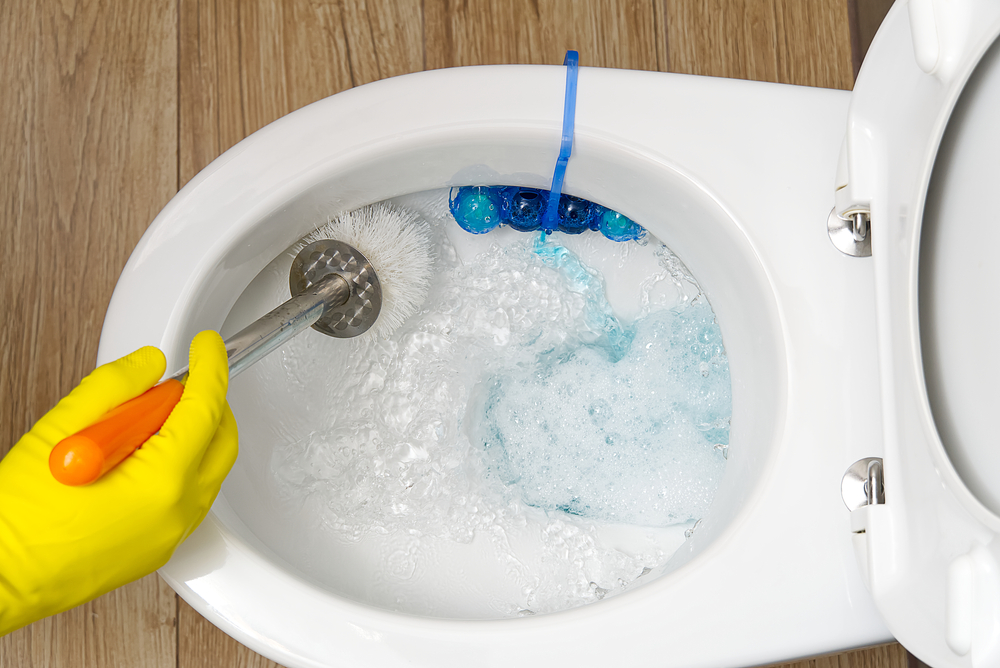Limescale can be a persistent problem in bathrooms, particularly in toilets, showers, and sinks. This chalky, white residue is caused by the buildup of calcium carbonate, often found in hard water. Approximately 85% of American homes have hard water, making limescale a widespread issue. If left untreated, limescale can damage fixtures, reduce water flow, and will create an unsightly appearance.
Here are three effective ways to remove and prevent limescale, ensuring your bathroom remains clean and functional.
1. Use Natural Cleaners to Remove Limescale
If you’re dealing with limescale buildup, natural cleaners like white vinegar and lemon juice can be surprisingly effective. These acidic solutions break down calcium carbonate, making it easier to scrub away the residue.
Steps to Remove Limescale:
- Toilets: Pour a cup of white vinegar into the bowl, ensuring it covers the stained areas. Let it sit for 1-2 hours before scrubbing with a toilet brush.
- Showerheads: Fill a plastic bag with vinegar and secure it around the showerhead using a rubber band. Let it soak overnight, then rinse thoroughly.
- Sinks and Taps: Mix equal parts of vinegar and water. Apply the solution to the affected areas using a cloth or sponge. Allow it to sit for 30 minutes before scrubbing and rinsing.
These methods are not only cost-effective but also eco-friendly. For tougher limescale deposits, you can add baking soda to the vinegar solution to create a more abrasive cleaner.
2. Invest in a Water Softener to Prevent Buildup
Since limescale stems from hard water, tackling the root cause is key to long-term prevention. Installing a water softener is one of the most effective ways to reduce the minerals that cause limescale. Water softeners work by exchanging calcium and magnesium ions for sodium or potassium, softening the water that flows through your pipes.
According to Energy.gov, water softeners can dramatically reduce limescale issues, improve hair and skin, extend appliance lifespans, and reduce cleaning needs.
Though the initial investment can be significant, the long-term benefits include reduced maintenance costs, improved water flow, and better protection for your plumbing system.
3. Regular Cleaning and Maintenance
Even with preventive measures, regular cleaning is essential to keep limescale at bay. Frequent cleaning prevents minor buildups from hardening into stubborn deposits. Here’s how to stay on top of it:
- Daily Wipe-Downs: Use a microfiber cloth to wipe sinks, taps, and shower surfaces after each use. This removes water droplets before they can leave mineral deposits.
- Weekly Deep Clean: Dedicate time once a week to clean all fixtures thoroughly. Use store-bought limescale removers or natural solutions to ensure every area is spotless.
- Descale Appliances: Descale items like kettles, coffee machines, and water heaters regularly to prevent internal buildup that can lead to inefficiency or damage.
If you notice early signs of limescale, address them immediately to avoid more significant problems. A local plumber can help you get control of your water hardness and any other quality issues you face.
Bonus Tips to Reduce Limescale
- Install Faucet Aerators: These devices reduce water flow, minimizing splashing and the amount of water that lingers on surfaces.
- Monitor Your Water Heater: Flushing your water heater annually helps remove sediment and prevents hard water deposits from affecting its performance.
- Use Cleaning Tablets: Drop anti-limescale tablets into your toilet tank periodically to reduce buildup in hard-to-reach areas.
Say Goodbye To Limescale
By combining natural cleaners, preventive measures like water softeners, and regular maintenance, you can effectively remove and prevent limescale buildup in your toilet, shower, or sink. Not only will these steps enhance the appearance of your bathroom, they will also protect your fixtures and plumbing from long-term damage.
Addressing limescale proactively is an investment in the value of your home and your daily comfort. If you’re ready to take action, start with the solutions above and reach out to us at Powell’s Plumbing if you need help!





Recent Comments